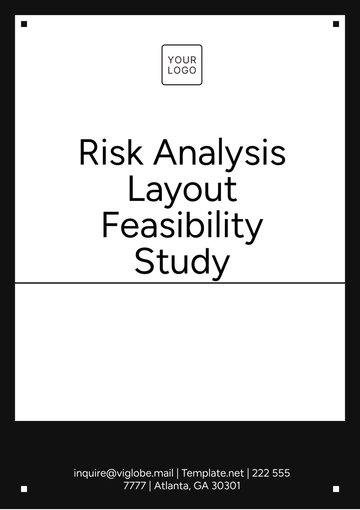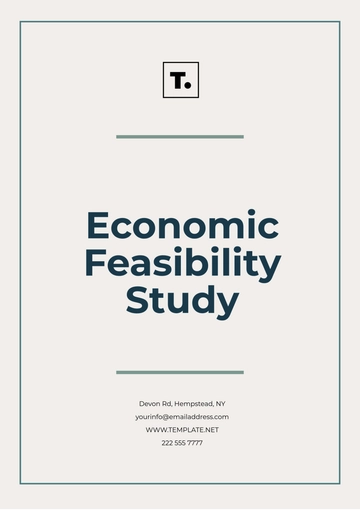Free Economic Feasibility Study

1. Executive Summary
This feasibility study evaluates the economic viability of installing a 500 kW solar power system at [Your Company Name] in Springfield, State. The project aims to reduce annual energy costs, enhance sustainability, and decrease the facility's carbon footprint. The study concludes that the project is economically viable, with a payback period of approximately 6.67 years and significant long-term savings.
2. Project Description
Location: [Your Company Name], Springfield, State.
Objective: To install a solar power system to generate renewable energy, reducing reliance on the local grid and lowering energy expenses.
Timeline:
Project Initiation: January 2051
Completion: June 2051
3. Market Analysis
Energy Market Overview: The average electricity cost in Springfield is currently $0.12 per kWh, with a projected annual increase of 3%.
Demand for Solar Power: The demand for renewable energy sources is increasing, with a 15% year-over-year growth in solar energy installations in the state.
Regulatory Environment: Available incentives include a 30% federal tax credit for solar energy systems and a state grant program offering $0.05 per watt.
4. Technical Feasibility
System Design: The proposed system includes:
Solar Panels: 1,500 high-efficiency solar panels (350W each).
Inverters: 2 central inverters with a combined capacity of 500 kW.
Installation Requirements: Roof-mounted system with minimal structural reinforcement needed.
Energy Output: Estimated annual output of 750,000 kWh, covering approximately 80% of the facility’s energy needs.
5. Financial Analysis
Initial Costs
Item | Cost |
|---|---|
Solar Panels and Inverters | $800,000 |
Installation and Labor | $150,000 |
Permits and Miscellaneous | $50,000 |
Total Initial Investment | $1,000,000 |
Operating Costs
Item | Annual Cost | Total Over 20 Years |
|---|---|---|
Maintenance | $10,000 | $200,000 |
Insurance | $5,000 | $100,000 |
Total Operating Costs | $15,000 | $300,000 |
Revenue Projections:
Annual Energy Savings: $150,000 (based on reduced grid energy usage).
Potential Revenue from Net Metering: $10,000 (selling excess power back to the grid).
6. Cost-Benefit Analysis
Total Costs Over 20 Years
Item | Amount |
|---|---|
Total Initial Investment | $1,000,000 |
Total Operating Costs | $300,000 |
Total Costs Over 20 Years | $1,300,000 |
Total Benefits Over 20 Years:
Item | Annual Amount | Total Over 20 Years |
|---|---|---|
Energy Savings | $150,000 | $3,000,000 |
Revenue from Net Metering | $10,000 | $200,000 |
Total Benefits | $160,000 | $3,200,000 |
Net Present Value (NPV): $500,000 (using a discount rate of 5%).
Internal Rate of Return (IRR): 10%.
Payback Period: 6.67 years.
7. Sensitivity Analysis
If electricity prices increase by 5% per year instead of 3%, the payback period shortens to 5.5 years.
A decrease in energy output by 10% would extend the payback period to 8 years.
8. Risk Assessment
Regulatory Changes: Potential for changes in incentives; recommend continuous monitoring of policy updates.
Market Fluctuations: Energy prices may decrease; consider locking in energy savings with long-term contracts.
Technology Failures: Regular maintenance schedules and warranties for equipment can mitigate risks.
9. Conclusion and Recommendations
The analysis shows that the solar power installation project is economically feasible, providing substantial long-term savings and environmental benefits. It is recommended to proceed with the project, considering the favorable financial indicators and potential for positive public relations.
Key Findings
Total Initial Investment: $1,000,000
Annual Savings: $150,000
Payback Period: 6.67 years
NPV: $500,000 over 20 years
IRR: 10%
- 100% Customizable, free editor
- Access 1 Million+ Templates, photo’s & graphics
- Download or share as a template
- Click and replace photos, graphics, text, backgrounds
- Resize, crop, AI write & more
- Access advanced editor
Unlock the potential of your project with the Economic Feasibility Study Template from Template.net. This fully customizable and editable template allows you to tailor your study to your specific needs. Effortlessly edit and refine your content using our AI Editor Tool, ensuring a professional and comprehensive feasibility study that drives informed decision-making.





























